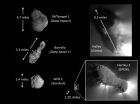(Press-News.org) CINCINNATI—It's no surprise that being a physician is a very stressful job and carries a lot of responsibility with it.
But two new studies from researchers at the University of Cincinnati (UC) indicate that the stressors arising from work in the clinic, where physicians are seeing patients one-on-one, can effectively be measured with hopes of improving patient care and physician job satisfaction.
Ronnie Horner, PhD, and C. Jeff Jacobson, PhD, both researchers in the department of public health sciences, say their studies, published in online editions of the journal Medical Care on Oct. 29 and Nov. 9, showed that certain known measurement tools for assessing non-clinical work intensity can also be used to determine physician work intensity in clinical settings.
"Work intensity for physicians during office-based patient care affects quality of care and patient safety as well as job satisfaction and reimbursement," says Horner. "There are existing intensity measures that have been used in previous studies of the work environment, but their validity in a clinical office setting hasn't been established."
Horner, Jerzy Szaflarski, MD, PhD, a researcher in the department of neurology and co-author on Horner's study, and Jacobson studied two main instruments: the NASA-Task Load Index (NASA-TLX) and the Subjective Workload Assessment Technique (SWAT).
For Jacobson's study, researchers used interviews and direct observations to obtain data.
"We wanted to document and describe subjective and observable work intensity dimensions for physicians in office-based clinical settings and examine them in relation to the measurement procedures and dimensions of the SWAT and NASA-TLX intensity measures," he says.
The study included 19 doctors—five family physicians, five general internists, five neurologists and four surgeons. Each physician was asked to describe low- and high-intensity work responsibilities, patients and events.
To document time, physicians were observed during a routine workday. Notes and transcript data were analyzed to identify and classify different aspects of work intensity.
"We found that work intensity factors identified by physicians matched dimensions assessed by standard instruments of work intensity. Physicians also reported work intensity factors outside of the direct patient encounter," Jacobson says, adding that across specialties, physician time spent in direct contact with patients averaged 61 percent for office-based services.
"Therefore, brief work intensity measures such as the SWAT and NASA-TLX can be used to assess work intensity in the office-based clinical setting," he says. "However, because these measures define the physician work 'task' in terms of effort in the presence of the patient, substantial physician effort dedicated to pre- and post-service activities is not included in these findings."
For Horner's and Szaflarski's study, the researchers used the NASA-TLX, SWAT and the Multiple Resources Questionnaire (MRQ) to measure perceived clinical work intensity associated with a given patient visit and for an entire half-day clinic; stress was measured by using the Dundee Stress State Questionnaire (DSSQ). Validity in the measurements was assessed by the correlation of the tools.
Fourteen providers from the same specialties—family medicine, internal medicine, neurology and surgery—were observed and assessed.
Researchers found that for the last patient encounter, there was a moderate to high correlation between the work intensity instruments' scores and low to moderate correlation with the distress subscale of the DSSQ.
"Provider personality was associated with reported levels of work intensity and stress," Horner says. "Similar results were obtained when the entire clinic session was our reference.
"Therefore, existing measures of work intensity and stress appear to be valid for use in the clinical setting to generate evidence on perceived intensity and stress experienced by providers in the performance of medical services."
Both Jacobson and Horner say more studies are needed to see if these measurements produce the same results or if the definition of measured tasks needs to be adapted to include the wider effort associated with complete patient care.
"If confirmed in larger studies, these instruments will provide a way of generating comparable information regarding the level of work intensity and stress associated with the performance of various medical services," says Horner. "In turn, such information could help improve health care delivery, such as improved efficiency in practice organization and management.
"Improved delivery is anticipated to yield higher quality of care and greater patient safety. The new information may also guide the establishment of physician incentives that will be proportional to actual work performed."
INFORMATION:
This project was funded in part by the American Academy of Neurology (AAN) and the American Academy of Dermatology (AAD).
Analysis shows stress on clinicians can be effectively measured
2010-11-11
ELSE PRESS RELEASES FROM THIS DATE:
ASN leads efforts to address growing crisis in kidney care
2010-11-11
An estimated 26 million people, 13% of the United States population, are living with Chronic Kidney Disease (CKD), and this number continues to grow. If current trends continue, there will not be enough doctors to serve this expanding patient population.
To help address this crisis, the American Society of Nephrology (ASN) is convening a Summit on the Nephrology Workforce during its upcoming ASN Renal Week 2010 in Denver, Colorado, on November 17. Participants will discuss this crisis, its implications, and strategies to increase the number of kidney disease doctors in ...
Putting the spotlight on membranous nephropathy
2010-11-11
The Halpin Foundation and the American Society of Nephrology (ASN) proudly highlight the research advances in membranous nephropathy made possible by The Halpin Foundation-ASN Research Grant, created to help young faculty develop independent research careers. This award provides recipients transition funding toward successful application for an NIH RO1 grant.
Elena Torban, PhD (McGill University Faculty of Medicine), the 2008 recipient of The Halpin Foundation-ASN Research Grant, recently explained, "The generous financial two-year support provided by The Halpin Foundation ...
Team colors on cans change perceptions of alcohol risks, MU study finds
2010-11-11
COLUMBIA, Mo. ¬— Underage and heavy drinking on college campuses continue to be issues for college administrators. While some campuses, such as the University of Missouri, have made strides in efforts to reduce heavy drinking on campus, administrators are continually trying to educate students about the risks of excessive drinking. Now, two MU psychologists have found that students who viewed images of beer cans packaged and displayed in university colors believed that drinking beer was less dangerous than those students who saw images of regular beer cans.
"In this research, ...
University of Minnesota leads team in discovery of novel type of magnetic wave
2010-11-11
A team of international researchers led by physicists in the University of Minnesota's College of Science and Engineering have made a significant breakthrough in an effort to understand the phenomenon of high-temperature superconductivity in complex copper-oxides—one of the most studied scientific topics in history.
The University of Minnesota researchers and their international colleagues from Germany, France and China report the discovery of a novel type of magnetic wave involving oxygen atoms. The new findings could have implications for improving superconducting ...
NIH scientists unveil mechanisms of immune reconstitution inflammatory syndrome
2010-11-11
WHAT:
Newly published research by scientists at the National Institute of Allergy and Infectious Diseases, part of the National Institutes of Health, sheds light on a poorly understood, acute illness called Immune Reconstitution Inflammatory Syndrome (IRIS) that develops in some HIV-infected individuals soon after they begin antiretroviral therapy.
IRIS affects certain HIV-infected individuals whose immune systems are heavily damaged by the virus and who have a treated or undiagnosed AIDS-associated infection. When these individuals start antiretroviral therapy and ...
Cassini's CIRS reveals Saturn is on a cosmic dimmer switch
2010-11-11
Like a cosmic light bulb on a dimmer switch, Saturn emitted gradually less energy each year from 2005 to 2009, according to observations by NASA's Cassini spacecraft.
But unlike an ordinary bulb, Saturn's southern hemisphere consistently emitted more energy than its northern one. On top of that, energy levels changed with the seasons and differed from the last time a spacecraft visited in the early 1980s. These never-before-seen trends came from an analysis of comprehensive data from the Composite Infrared Spectrometer (CIRS), an instrument built by NASA's Goddard Space ...
Primordial dry ice fuels comet jets
2010-11-11
COLLEGE PARK, Md. – One of the biggest comet findings coming out of the amazing images and data taken by the University of Maryland-led EPOXI mission as it zipped past comet Hartley 2 last week is that dry ice is the 'jet' fuel for this comet and perhaps many others.
Images from the flyby show spectacular jets of gas and particles bursting from many distinct spots on the surface of the comet. This is the first time images of a comet have been sharp enough to allow scientists to link jets of dust and gas with specific surface features. Analysis of the spectral signatures ...
Pleasurable behaviors reduce stress via brain pathways, research shows
2010-11-11
CINCINNATI—Whether it's food or sex, pleasurable activity provides more than just pleasure, University of Cincinnati (UC) researchers say. It actually reduces stress by inhibiting anxiety responses in the brain.
The findings were published online Nov. 8, 2010, ahead of print in PNAS, the official journal of the National Academy of Sciences.
Experiments designed by Yvonne Ulrich-Lai, PhD, research assistant professor, James Herman, PhD, director of the Laboratory of Stress Neurobiology and professor of psychiatry and behavioral neuroscience at UC, and colleagues also ...
Economists reveal factors that help poor people lift themselves out of poverty
2010-11-11
What factors contribute to poor people in developing countries lifting themselves out of poverty?
A paper by economists Anan Pawasutipaisit of Thammasat University and Robert M. Townsend of MIT provides important insights into what kinds of households might be most effective at moving themselves out of poverty and how they are able do it.
The paper, "Wealth Accumulation and Factors Accounting for Success" appears in the current issue of the Journal of Econometrics. It suggests that poor people who skillfully manage their assets are especially successful in improving ...
Noninvasive brain stimulation helps improve motor function in stroke patients
2010-11-11
BOSTON -- A noninvasive electric stimulation technique administered to both sides of the brain can help stroke patients who have lost motor skills in their hands and arms, according to a new study led by researchers at Beth Israel Deaconess Medical Center (BIDMC).
Described in today's Online Issue of the journal Neurology, the findings showed that stroke patients who received bihemispheric transcranial direct current stimulation (tDCS) coupled with a regimen of physical and occupational therapy had a three-fold greater improvement in motor function compared with patients ...

